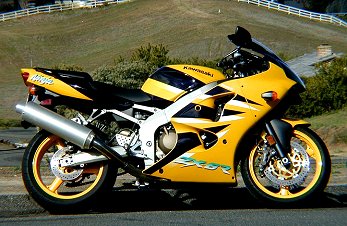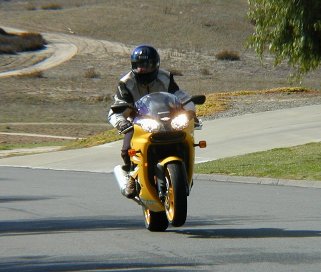
If you read MD often, you probably know by now that we love the 600cc sportbikes. They are arguably the best bargain in motorcycling, the . . . “do it all” machines. Capable of commuting one day and turning fast laps at a race track the next, the 600s are reasonably priced and generally bullet proof.
Last year, we fell in love with Kawasaki’s ZX-6R, and most of the enthusiast publications agreed. Winning 600cc Sportbike of the Year in several shoot-outs last year, the ZX-6R combined comfortable ergonomics and practicality with race track prowess. Eric Bostrom nearly took the ZX-6R to the AMA 600 Supersport title (losing that title by a few feet in the last race). When we rode the bike last year, we raved about it and you can read our reviews here and here.
Although largely unchanged this year (except for the new paint jobs), we wanted to ride the ZX-6R with a different focus. As the most ergonomically comfortable bike in the class, with the largest, most protective fairing, we wanted to evaluate the ZX-6R as a street bike only, and with an emphasis on sport touring. We wanted to test our theory that a 600 can be an excellent sport tourer, with less weight and at least equal performance to the dedicated sport tourers (including plenty of mid-range power — a hallmark of the ZX-6R power plant).
We rode the bike extensively around Southern California, dodging the unusually cold and wet California Winter, when we could.

The first things you notice about the 6R are its striking new graphics (in our situation, a combination of yellow, white and deep purple) and, when sitting on the bike, its comfort. The ZX-6R has the most upright riding position of the current crop of 600s, while still remaining sporty enough for the dedicated sport riders. This comfortable riding position means even more behind the large, protective fairing — clearly the most protective of the current 600s.
The reach to the bars is reasonable, and they are higher than most of the other bikes in the class. Additionally, the footpegs are low enough to keep even taller riders from feeling too cramped. The pegs also have a rubber surface, for less vibration and more long distance comfort than purely metal pegs offer.
Along with Yamaha’s R6, the Kawasaki ZX-6R is the last carbureted bike in the 600 class. This means that you will have to warm up this bike longer than some of the competitors’ machines. Throttle response, although excellent for a carbureted bike, does suffer in comparison to Honda’s new F4i and Suzuki’s GSX-R600 (both with new fuel injection systems). Nevertheless, once warm and ready to go, the ZX-6R power plant is smooth and responsive. Arguably, at least, it is the best 600 motor for the street, with mid-range power that rivals or exceeds the competition. Kawasaki gets outdone in peak horsepower this year, however, by some of the other 600s, including Suzuki’s powerful GSX-R.
But this test emphasized the real world, where mid-range power is king. Between 6000 and 10,000 rpm, the Kawasaki is crisp and powerful, and emits an entertaining and soulful exhaust note (something Kawasaki’s Ninjas have long been known for).
On the freeway, the ZX-6R motor is very smooth. Vibration levels are lower than most of the 600s competing with the Kawasaki, and the fairing protection is most appreciated at elevated freeway speeds. The mid-range power makes passing a simple matter, although, like all 600s, the ZX-6R will require a downshift or two to get into the meat of its powerband.

The ZX-6R comes with Dunlop’s popular D207 tires. An unusual 65 series front tire is supposed to combine the best of the taller 70 series and shorter 60 series rubber, stability and quick turning. The stiff, twin-spar aluminum chassis and beefy 46mm front fork combine with these tires to create quick, but stable handling. Indeed, it was the ZX-6R’s handling on the street, as much as anything else, that led the press to gush over this model when it was revamped last year. The bike is extremely easy to ride, and generates a high level of confidence.
The ZX-6R still has perhaps the best modulated front brakes in the business. The switch last year to differential bore, six-piston calipers and a new pad compound made a huge difference both in feel and outright power. The brakes are still outstanding, and perhaps my favorites.
With plenty of adjustability, the Kawasaki’s suspension can be dialed to suit the tastes of most riders. Our only complaint is some harshness in high speed compression damping in the front fork. Something we noticed only while traversing unusually rough pavement (potholes, for instance). Most of the time, the suspension worked well with the rest of the package, and contributed to the all-around good handling of the bike.
The six-speed transmission has well placed ratios, and gear engagement is not a problem. Finding neutral was an occasional problem, however. For some reason, it was very difficult to find neutral while coasting to a stop, for instance.
The ZX-6R’s instrumentation is relatively complete, including a clock and engine coolant temperature gauge. The analog speedometer is a little unusual these days (other bikes in the class have switched to digital speedometers), but was easy to read. The only feature lacking in its instrumentation is a gas gauge — a feature you will miss on longer trips. Fortunately, the ZX-6R has a fairly good range on reserve, should you need it.

You have probably figured out that we like Kawasaki’s ZX-6R. There are lots of reasons, but they can be summarized like this. We like the comfort of a sport tourer, with the flickability of a light, hard-core sportbike thrown in. At 80 to 100 pounds lighter than many dedicated sport tourers, and nearly the same comfort level (and at a far lower price), the Kawasaki ZX-6R is a hard package to beat for the street. It also proves our theory that some of today’s 600s have plenty of mid-range engine performance to make for good sport touring. In the real world, the 2001 ZX-6R is simply a great motorcycle that will satisfy a large group of street riders.
U.S. MSRP for the 2001 ZX-6R is $7,899. Here is a link to Kawasaki’s ZX-6R page for details and specifications.





